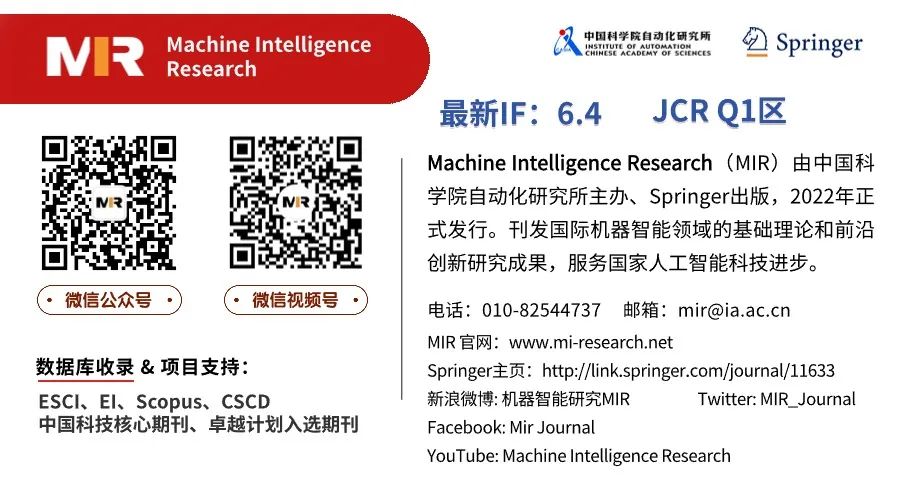Machine Intelligence Research
MIR专题"Multimodal Learning, Temporal Modeling, and Foundation Models for Video Understanding"现公开征集原创稿件,截稿日期为2025年3月31日。欢迎赐稿!
▼
专题简介
Video understanding focuses on interpreting dynamic visual information from video data to recognize objects, actions, interactions, and environments in a time-structured manner. It has emerged as a critical area of research in computer vision due to its wide-ranging applications in autonomous systems, video surveillance, entertainment, healthcare, and human-computer interaction. Recent advancements in deep learning, especially in areas like spatiotemporal processing, multimodal learning, and graph-based modeling, have significantly enhanced model’s ability to comprehend complex video scenes. Despite significant advancements, the following key challenges continue to pose obstacles to developing accurate, efficient, and robust systems:
1. High Dimensionality and Computational Complexity: Videos are inherently high-dimensional data, with multiple frames contributing to a vast amount of information. Analyzing these sequences requires models to be capable of efficiently processing both spatial and temporal information, which often leads to high computational costs. Balancing the accuracy of video understanding models with the need for real-time processing in applications such as autonomous driving or video surveillance is a pressing challenge.
2. Temporal Coherence and Long-term Dependencies: Understanding events in a video often relies on tracking objects and interpreting their actions over time. Capturing temporal coherence, especially over long sequences, is difficult due to the need to model both short-term interactions and long-term dependencies between different entities. Traditional methods struggle with maintaining consistent object tracking and event detection across extended time frames.
3. Multimodal Integration: Video data encompasses more than just visual information—auditory cues, text description, and motion data are also essential for comprehending scenes. The challenge lies in effectively fusing these modalities to provide a holistic understanding of the scene. Many systems still struggle with aligning and integrating multimodal inputs in a meaningful way that improves recognition and interpretation accuracy.
4. Ambiguity in Action and Event Recognition: Distinguishing between similar actions or events in a video can be highly ambiguous. For example, the actions of sitting down and falling can appear visually similar, yet have vastly different meanings. Accurately recognizing and categorizing these nuanced actions requires models with a deep understanding of spatiotemporal context, which is challenging to achieve, especially in complex environments with multiple actors and activities.
5. Occlusion and Viewpoint Variations: In real-world scenarios, objects or people in a video often get occluded or appear from different angles. These occlusions and viewpoint changes can obscure key parts of the scene, leading to ambiguity in identifying actions and objects. Models need to be robust enough to handle partial visibility, changes in camera angles, and dynamic environments, but current systems frequently fall short in such situations.
6. Data Annotation and Scalability: Training effective video understanding models often requires large, annotated datasets. However, manually labeling video data is time-consuming and expensive, particularly when considering both spatial and temporal dimensions. The scalability of current solutions is limited by the availability of largely annotated datasets, and the development of models capable of learning from less data or through self-supervision is still in its infancy.
7. Adaptation and Generality: Many state-of-the-art models are trained on curated datasets that may not fully represent the complexity of real-world environments. When deployed in the real world, these models often encounter variations in lighting, weather, and unpredictable interactions, leading to performance degradation. Ensuring that models can generalize to unseen environments and adapt to changing conditions is an ongoing challenge.
征稿范围(包括但不限于)
We believe that this special issue will offer a timely collection of research outcomes to benefit video understanding in the long run. Topics of interest include but are not limited to:
• Temporal Dynamics and Spatiotemporal Feature Extraction: Leveraging advanced techniques to model temporal dependencies and relationships between objects and events over time, e.g., graph neural networks and transformers.
• Multimodal Learning for Video Understanding: Integrating visual, auditory, text, or motion information to improve scene comprehension.
• Scene Segmentation in Videos: Enhancements in accurately segmenting dynamic scenes across frames, e.g., video semantic segmentation, video instance segmentation, video panoptic segmentation, video object segmentation, motion segmentation, scene change detection, interactive video segmentation, and video salient object detection.
• Object Tracking in Videos: Advancements in accurately tracking objects across video frames, e.g., single/multiple object tracking, long-term object tracking, trajectory prediction, video object/person re-identification, multimodal object tracking, 3D object tracking, and joint tracking and segmentation.
• Action Recognition and Event Detection: New methods for identifying and distinguishing complex actions and events in videos, e.g., action segmentation, video summarization/captioning, action label prediction, video prediction, video retrieval, procedure and action understanding, and video grounding.
• Data/Label Efficient Video Learning: Developing new techniques for self-supervised learning, unsupervised learning, few-shot learning, and semi-supervised learning with videos.
• Personalization of Large Foundation Models for Video Understanding: Advanced techniques for personalizing large foundation models (LFMs) for video understanding, e.g., using LFMs for video segmentation and tracking.
投稿指南
1) 截稿日期:2025年3月31日
2) 投稿地址(已开通):
https://mc03.manuscriptcentral.com/mir
投稿时,请在系统中选择:
“Step 6 Details & Comments: Special Issue and Special Section---Special Issue on Multimodal Learning, Temporal Modeling, and Foundation Models for Video Understanding”.
3) 投稿及同行评议指南:
Full length manuscripts and peer reviewing will follow the MIR guidelines. For details: https://www.springer.com/journal/11633
客座编委
• Yun Liu
Agency for Science, Technology and Research (A*STAR), Singapore
Email: vagrantlyun@gmail.com
ETH Zurich, Switzerland
Email: sunguolei.kaust@gmail.com
University of Wurzburg, Germany & ETH Zurich, Switzerland
Email: Radu.Timofte@uni-wuerzburg.de
ETH Zurich, Switzerland
Email: ender.konukoglu@vision.ee.ethz.ch
ETH Zurich, Switzerland & KU Leuven, Belgium & Institute for Computer Science, Artificial Intelligence and Technology (INSAIT), Bulgaria
Email: vangool@vision.ee.ethz.ch
MIR为所有读者提供免费寄送纸刊服务,如您对本篇文章感兴趣,请点击下方链接填写收件地址,编辑部将尽快为您免费寄送纸版全文!
说明:如遇特殊原因无法寄达的,将推迟邮寄时间,咨询电话010-82544737
收件信息登记:
https://www.wjx.cn/vm/eIyIAAI.aspx#
关于Machine Intelligence Research
Machine Intelligence Research(简称MIR,原刊名International Journal of Automation and Computing)由中国科学院自动化研究所主办,于2022年正式出版。MIR立足国内、面向全球,着眼于服务国家战略需求,刊发机器智能领域最新原创研究性论文、综述、评论等,全面报道国际机器智能领域的基础理论和前沿创新研究成果,促进国际学术交流与学科发展,服务国家人工智能科技进步。期刊入选"中国科技期刊卓越行动计划",已被ESCI、EI、Scopus、中国科技核心期刊、CSCD等20余家国际数据库收录,入选图像图形领域期刊分级目录-T2级知名期刊。2022年首个CiteScore分值在计算机科学、工程、数学三大领域的八个子方向排名均跻身Q1区,最佳排名挺进Top 4%,2023年CiteScore分值继续跻身Q1区。2024年获得首个影响因子(IF) 6.4,位列人工智能及自动化&控制系统两个领域JCR Q1区。

内容中包含的图片若涉及版权问题,请及时与我们联系删除





评论
沙发等你来抢